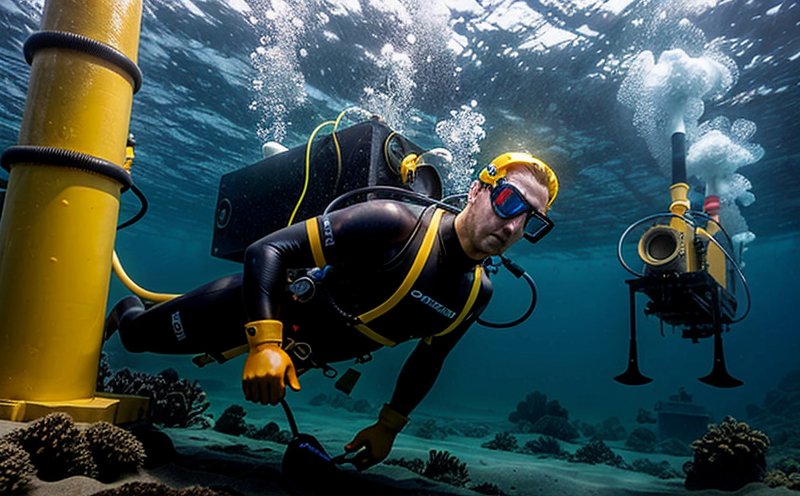ASTM D1735 Water Fog Resistance Testing of Subsea Coatings
The ASTM D1735 water fog resistance testing is a critical procedure used to evaluate the performance and durability of subsea coatings. This test is particularly important for ensuring that coatings can withstand the harsh marine environment, which includes exposure to saltwater, pressure variations, and aggressive chemicals.
Subsea equipment operates in an environment where it must perform reliably over extended periods without failure or degradation. Coatings applied to these components play a key role in protecting them from corrosion, fouling, and other forms of deterioration. The ASTM D1735 test simulates the conditions that subsea coatings might encounter during their service life. By subjecting the coating to water fog, which mimics salt-laden spray found at sea, the test assesses whether the coating can maintain its integrity.
The water fog resistance test is conducted in a specialized chamber where the specimen (typically a small section of the subsea coating) is exposed to a controlled environment. This environment includes a misting system that simulates the effects of water spray. The duration and intensity of this exposure are carefully regulated according to ASTM D1735 standards.
Following the test, the integrity of the coating is visually inspected for signs of degradation such as blistering, cracking, or peeling. If the coating passes the test without showing significant damage, it can be concluded that the coating is suitable for subsea applications. Conversely, if the coating fails, further investigation may be required to identify potential issues and improve the formulation.
This testing procedure is particularly relevant in sectors such as offshore oil & gas exploration, deep-sea mining, and naval engineering where equipment must operate reliably under severe conditions. The results of ASTM D1735 tests are essential for quality assurance and compliance with international standards.
- Visual inspection of the coated specimen after exposure
- Documentation of any observed changes in coating integrity
- Possibility to repeat testing if initial results indicate potential issues
The ASTM D1735 test is just one part of a broader quality assurance program that ensures the reliability and durability of subsea equipment. It is essential for maintaining compliance with industry standards and ensuring the longevity of critical infrastructure.
Why It Matters
The importance of ASTM D1735 water fog resistance testing cannot be overstated in the context of marine & ship equipment, especially subsea components. The harsh marine environment poses significant challenges for coating materials that are used to protect critical subsea equipment.
- Protecting against corrosion and fouling
- Maintaining operational efficiency under extreme conditions
- Sustaining the integrity of coatings over extended periods
The marine industry relies heavily on robust subsea equipment for activities such as oil & gas extraction, deep-sea mining, and naval operations. These operations are conducted in environments where water spray is a constant presence. The ASTM D1735 test ensures that the coatings used on these components can withstand similar conditions without failing.
The results of this testing play a crucial role in ensuring compliance with international standards such as ISO 12944 and EN 15728, which provide guidelines for the protection of industrial equipment from corrosion. By adhering to these standards, manufacturers ensure that their products are reliable and can operate effectively over long periods.
Failure to meet the requirements of ASTM D1735 or other relevant standards could lead to premature failure of subsea coatings, resulting in costly repairs and potential safety hazards. Therefore, rigorous testing like ASTM D1735 is essential for maintaining quality control and ensuring that equipment can perform reliably under challenging conditions.
Quality and Reliability Assurance
The ASTM D1735 water fog resistance test is a vital component of the broader quality assurance program used in marine & ship equipment, particularly for subsea components. This section outlines the key aspects that contribute to ensuring the reliability and durability of coatings through this testing process.
- Visual Inspection: After exposure to water fog, the coated specimen is visually inspected for any signs of damage such as blistering, cracking, or peeling.
- Data Collection: Detailed records are kept throughout the test, including environmental conditions and any observations made during inspections.
- Repeatability: The test can be repeated if initial results suggest potential issues, ensuring consistent and reliable data.
The ASTM D1735 test is designed to simulate real-world conditions faced by subsea coatings. By subjecting the coating to controlled water fog exposure, this procedure evaluates its resistance to degradation under specific environmental stressors. This helps manufacturers identify any weaknesses in their formulations early on, allowing for necessary adjustments and improvements.
Quality assurance through ASTM D1735 testing is essential not only for meeting regulatory requirements but also for maintaining the reputation of equipment manufacturers. Reliable coatings enhance customer confidence and ensure that subsea equipment operates efficiently over extended periods without requiring frequent maintenance or replacements.
International Acceptance and Recognition
The ASTM D1735 water fog resistance test is widely accepted and recognized within the international community for its role in ensuring the reliability of subsea coatings. This section highlights the significance of this standard in global markets and its acceptance by various regulatory bodies.
- Regulatory Bodies: Compliance with ASTM D1735 is often a requirement for equipment to be approved by major regulatory authorities such as the American Bureau of Shipping (ABS) and Lloyd's Register.
- Industry Standards: The test aligns with international standards like ISO 12944, which provides guidelines for the protection of industrial structures from corrosion. This alignment ensures that coatings meet global quality expectations.
The acceptance of ASTM D1735 is further enhanced by its widespread use in major industries such as offshore oil & gas and naval engineering. Manufacturers who adhere to this standard can ensure their products are compatible with international specifications, facilitating easier market entry into different regions.
International recognition of ASTM D1735 also contributes significantly to the reputation of manufacturers. Companies that demonstrate compliance with these stringent testing procedures gain credibility among clients and stakeholders, fostering trust in the quality and reliability of their products.





